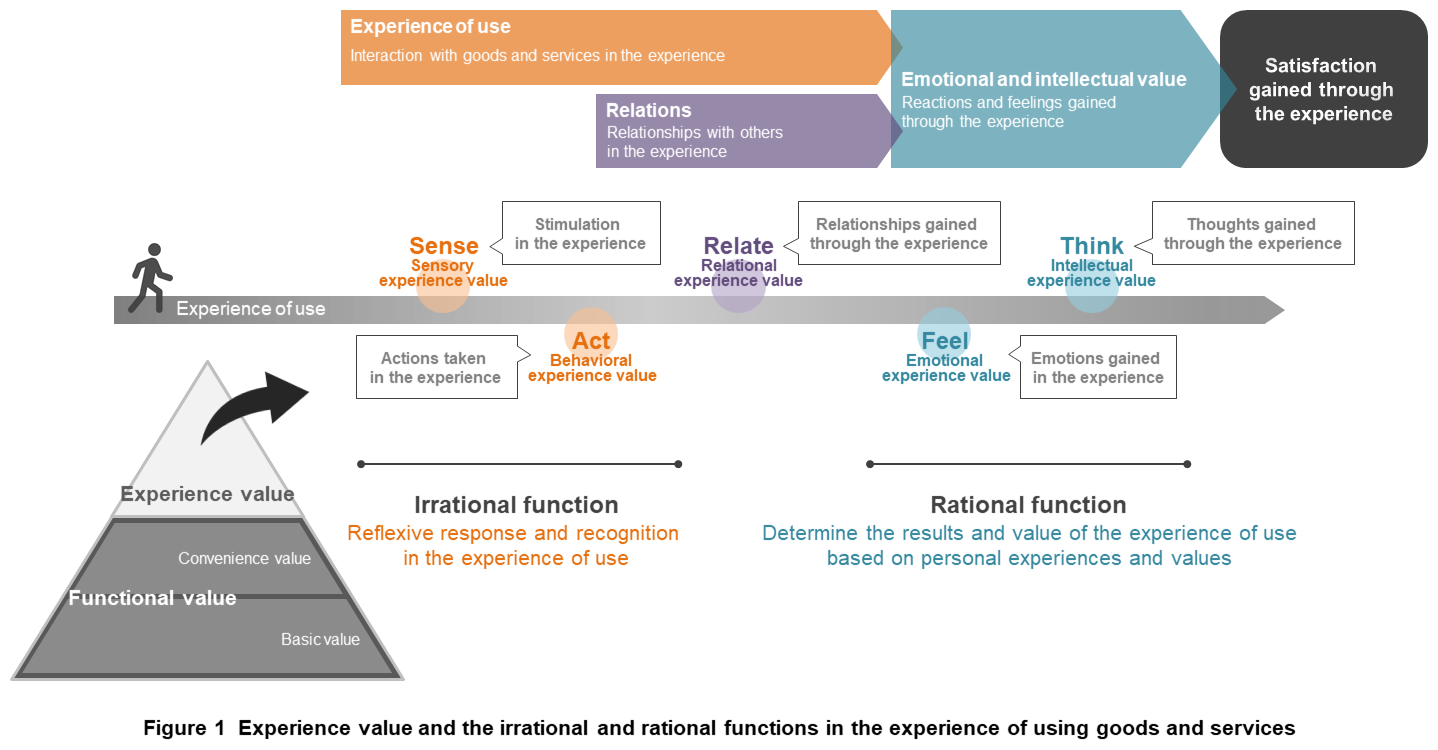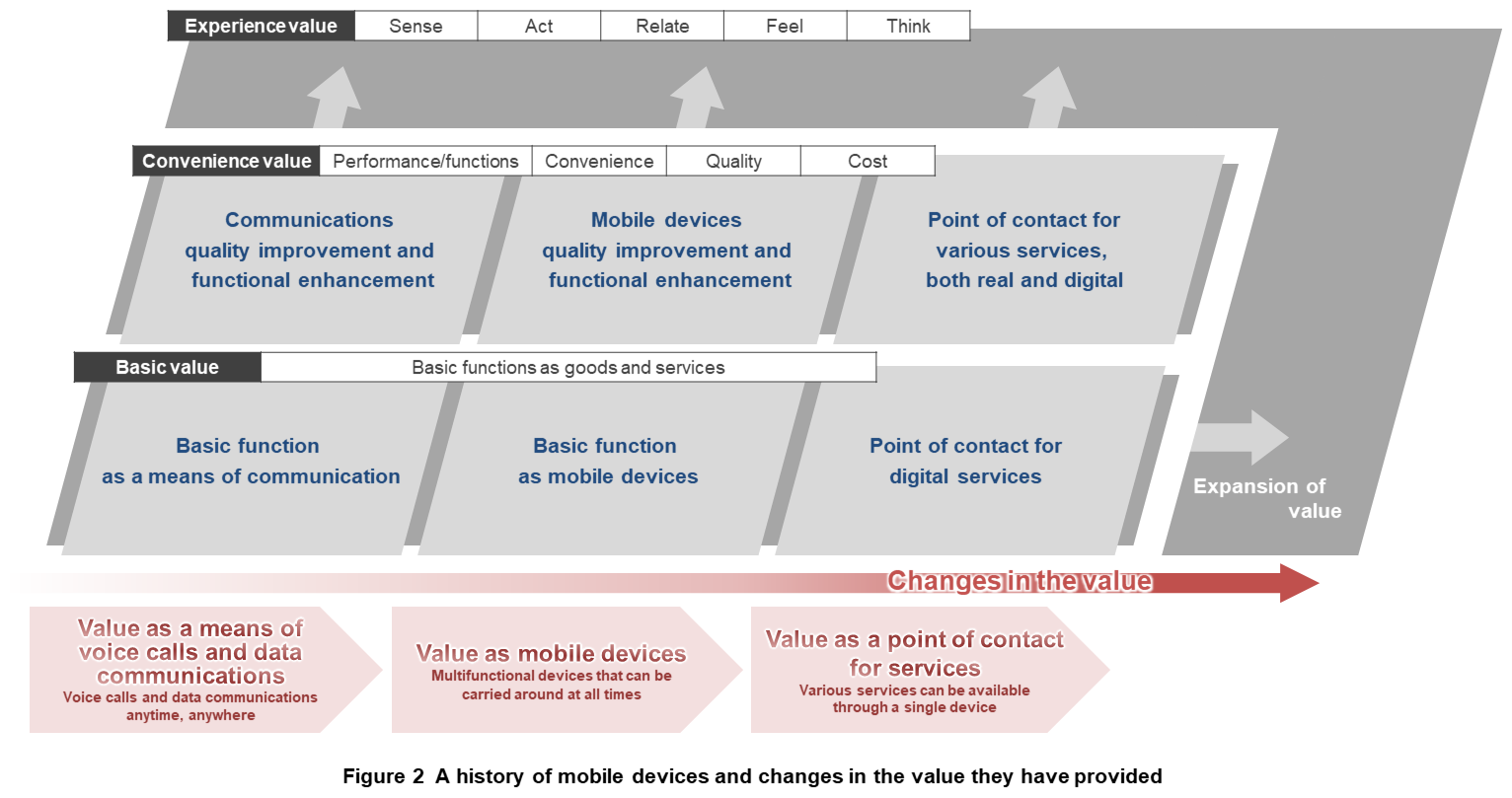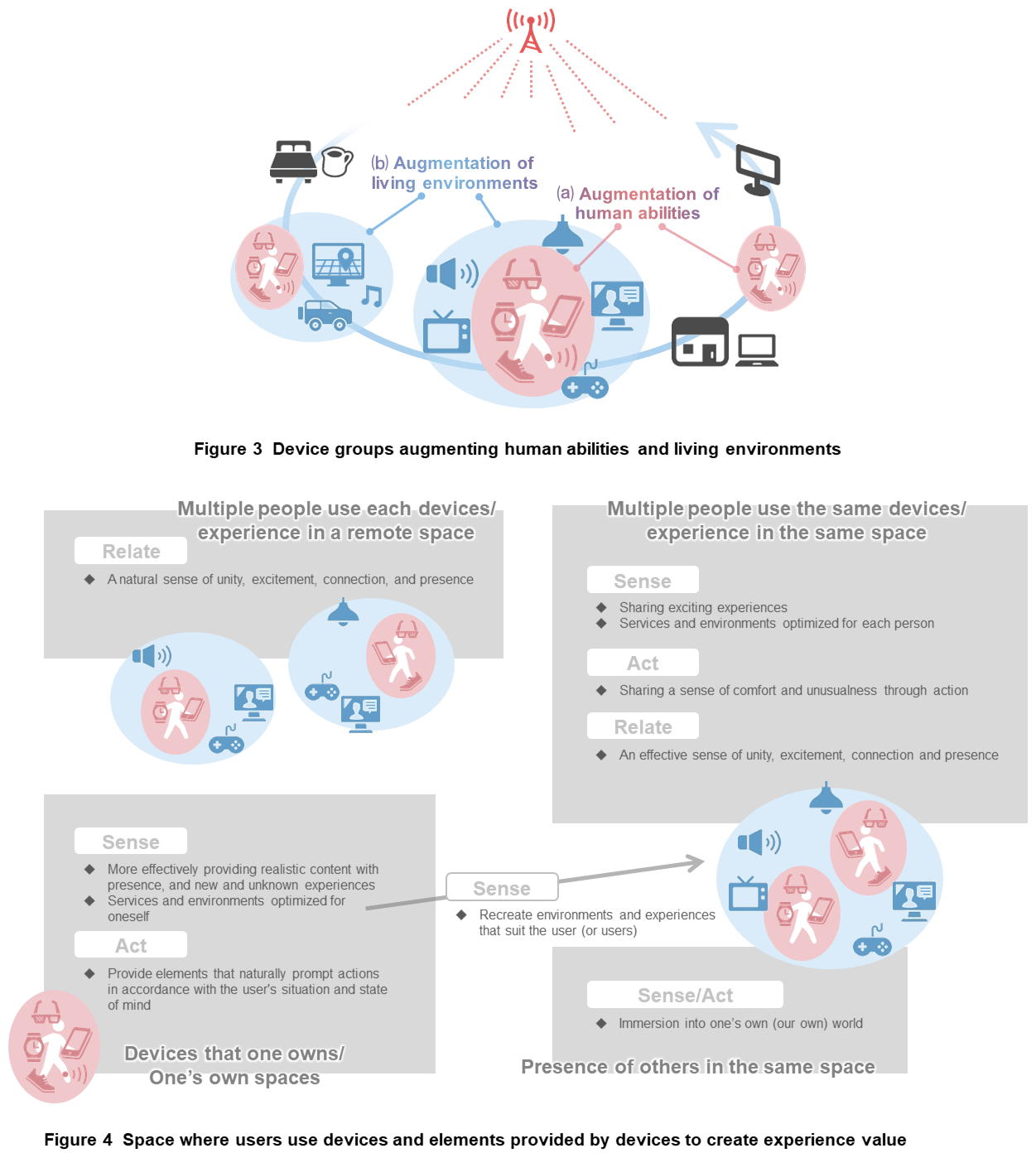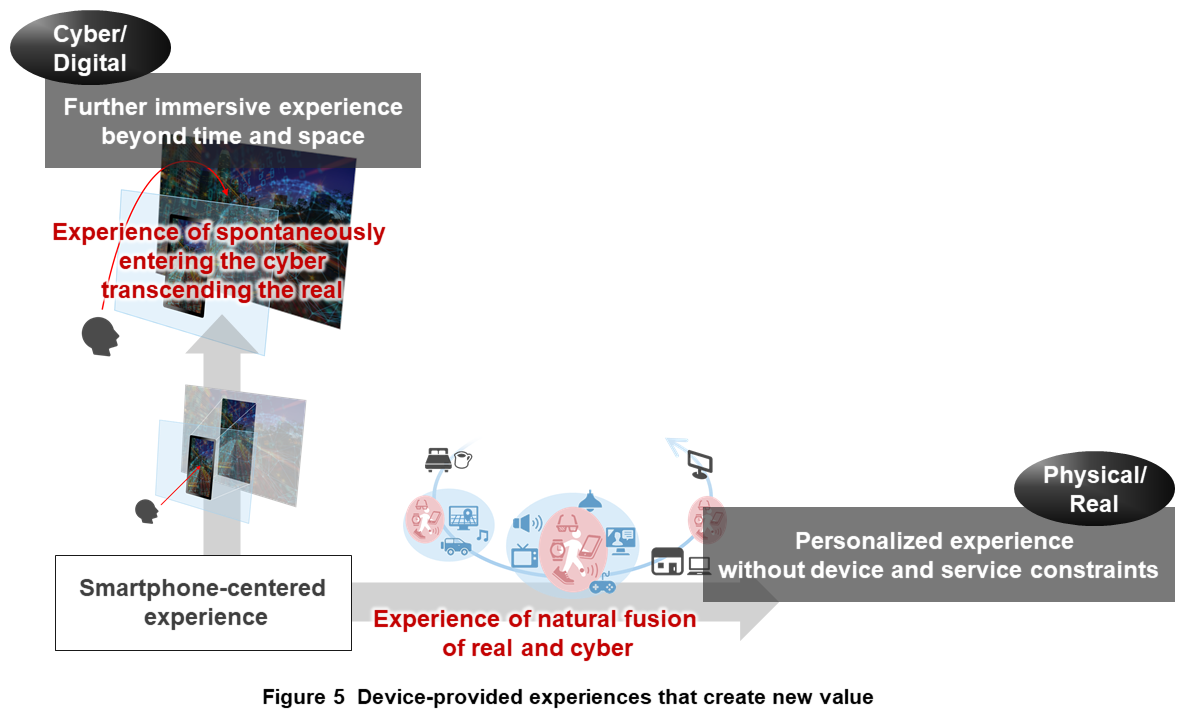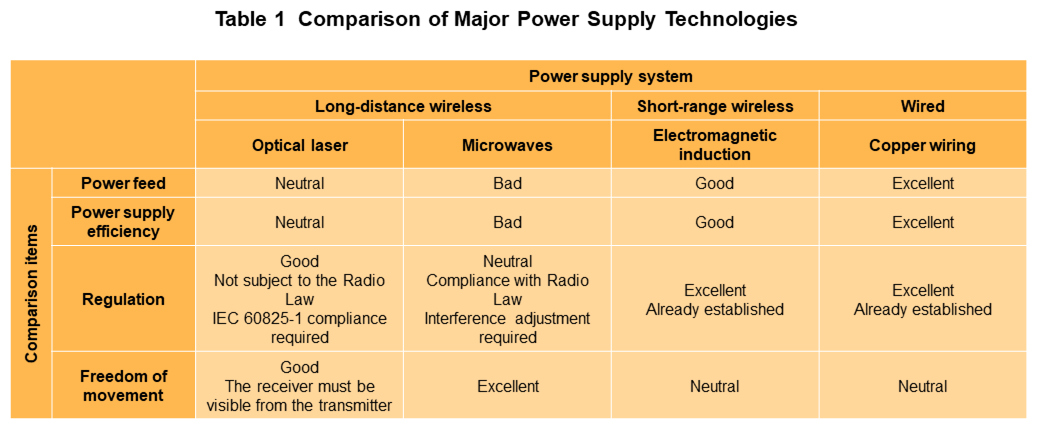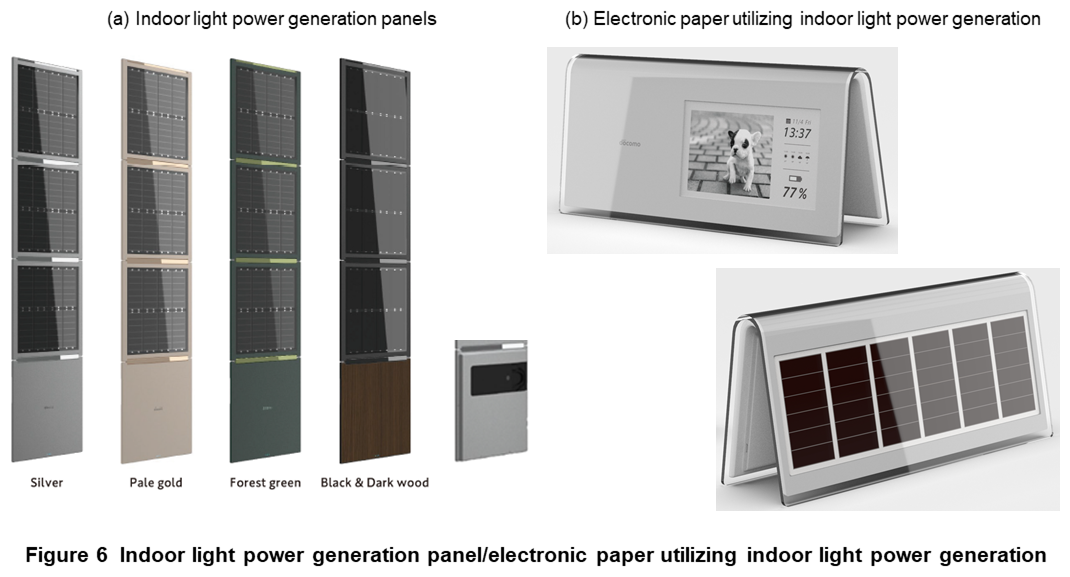Special Articles on 5G Evolution & 6G (2)—Initiatives toward Implementation and Use Cases—
Evolving Experiences and Device Technologies for the Future Devices in the 6G and IOWN Era
Power Supply Technology Carbon Neutral Device
Takeshi Higuchi
DOCOMO CS, Inc. Communication Device Support Group, Communication Device Support Division
Hitoshi Araya, Mitsukazu Yokoyama, Akira Nakamoto and Sachiyo Hamazaki
Device-Tech Development Department
Abstract
Today's smartphones are important customer contact points that deliver all kinds of services to users. As provided value shifts from “things-oriented value” to “experience-oriented value” and the importance of customer contact points increases, devices are expected to create new value in the era in which the NTT Group's 6G/IOWN concept is implemented.
Aiming to realize the 6G/IOWN concept, NTT DOCOMO strives to develop the “Charging Stress-free & Carbon-free Device” that is compact and lightweight, reduces charging stress, and contributes to carbon neutrality by reducing device power consumption by incorporating photonics-electronics convergence technologies, which is currently in research and development, into semiconductors, and by utilizing device-embedded technologies such as next-generation power supply technologies.
01. Introduction
-
Today's smartphones are important customer contact points ...
Open

Today's smartphones are important customer contact points that deliver all kinds of services to users. As provided value shifts from “things-oriented value” to “experience-oriented value” and the importance of customer contact points increases, devices are expected to create new value in the era in which the NTT Group's 6G/Innovative Optical and Wireless Network (IOWN)*1 concept is implemented.
Aiming to realize the 6G/IOWN concept, NTT DOCOMO strives to develop the “Charging Stress-free & Carbon-free Device” by incorporating photonics-electronics convergence technologies, which is currently in research and development, into semiconductors and applying next-generation power supply technologies to the device. This device will enhance the flexibility of the user experience by achieving compact and lightweight design and low charging stress and contribute to achieving carbon neutrality*2 by reducing device power consumption and utilizing renewable energy for the creation of a sustainable society.
This article examines the current and future value provided by devices and describes the approach to device-embedded technologies aimed at solving user experience issues in next-generation devices.
- IOWN: A next-generation ICT infrastructure platform announced by NTT in May 2019. By utilizing optical and other innovative technologies, NTT will create new value through network and information processing platforms, including devices, that can provide low latency and low power consumption, large-capacity and high-quality communications, and vast computing resources.
- Carbon neutral: Balancing the emission and absorption of greenhouse gas. NTT DOCOMO has declared that it will become “carbon neutral,” meaning that its greenhouse gas emissions from its business activities will be virtually zero by 2030 (announced in September 2021). To contribute to the carbon neutrality of society as a whole, not only by NTT DOCOMO but also with its customers and partners, NTT DOCOMO launched the slogan, “Changing environment with you.” Under this slogan, NTT DOCOMO also launched “Caboneu,” a carbon-neutral initiative.
-
As consumer behaviors change, the value provided by goods ...
Open

As consumer behaviors change, the value provided by goods and services has shifted from goods or functions to experiences, and instead of differentiation based on “functional value to resolve absence/impossibility/disadvantages,” demands have shifted to differentiation based on advanced added value such as sensory and emotional value. Schmidt proposed experience value and defined the value of goods and services as “user reactions (internal reactions and interactions with external activities) that lead to the “satisfaction” obtained in the experience of using goods or services.” Schmidt classifies the value of goods and services into five categories: Sense (sensory experience value), Act (behavioral experience value), Feel (emotional experience value), Think (intellectual experience value), and Relate (relational experience value) [1] [2]. Jung also advocated psychological functions and stated that humans experience the world through “direct reactions to experiences” by irrational functions consisting of sensation and intuition, and “judgments about experiences based on personal experiences and values” by rational functions consisting of feeling and thinking [3]. The relationship between experience value and irrational and rational functions in the experience of using goods and services is shown in Figure 1.
The experience of using goods or services is formed by a series of passive (Sense) or active/interactive (Act) actions between the user and the goods or services during the experience. Relationships (Relate) that occur in an experience involving others can also be considered elements that form the experience. Emotions (Feel) and thoughts (Think) are obtained as a result of the experience, and are regarded as evaluations of Sense, Act, and Relate. Considering the psychological functions proposed by Jung, among the five experience values, Sense and Act are the interactions with goods and services experienced by the irrational functions, Feel and Think are the evaluations judged by the rational functions as a result of the experience, and Relate is the evaluation of the human relationships obtained as a result of involvement with others by the rational functions.
From this, it can be considered that pursuing the value provided by goods and services means improving the interaction between the user and the goods and services in the experience and creating better relationships with others, thereby enhancing the emotions and thoughts obtained, and as a result, making the user feel a sense of satisfaction. In this way, as this is a process in which satisfaction of the experience increases as Feel and Think are created from the elements of Sense, Act, and Relate, it is important to pursue the experience itself of using the goods and services. Following, we describe more specifically the experiences that create the value of Sense, Act, and Relate, which constitute the experience of use.
2.1 Sense (Sensory Experience Value)
The sensory component of experience is the stimulation to the five senses that occurs during the experience. We believe that this stimulation has two aspects: a “stimulating experience” in which the stimulation at a certain moment is greater, and a “comfortable experience” in which the stimulation is smaller (so that the user is not aware of stimulation). These two aspects can be broken down in terms of which is more strongly perceived by the irrational functions of sensation or intuition. Stimulating experiences can be divided into those that entail feeling a sense of presence and reality with expanded five senses (sensation) and those that entail feeling the new and unknown (intuition), while comfortable experiences can be divided into optimized environments and experiences where the stimulation is moderate and pleasant (sensation) and the usual environment and preferred experience where the user feels that it is suits him or her (intuition).
2.2 Act (Behavioral Experience Value)
Actions and behaviors performed in the experience can be broadly classified into those that are means to the objective and those that are the objectives. Actions and behaviors with an objective are the labor and work to perform something. Reducing such actions and behaviors leads to an improvement in experience value, although this is “resolution of absence/impossibility/disadvantages through functional value” and is not the experience value discussed here. On the other hand, when a behavior itself is the objective and generates satisfaction, it is considered to be an experience value.
We believe that actions and behaviors themselves are the objective, i.e., actions and behaviors that have value in themselves can be defined by which of the irrational functions, sensation or intuition, is more strongly perceived—actions and behaviors that bring about experiences of comfort and pleasantness (sensation), or actions and behaviors that create contexts for uplifting and extraordinary experiences [4] (intuition).
2.3 Relate (Relational Experience Value)
We believe that the stimulation from a sense of unity and excitement, and the feeling of connection and presence, are elements of an experience, because involvement with others in the experience can make us feel or strengthen our connection to others, and this can lead to good feelings and thoughts and give us a sense of satisfaction.
-
Of all customer contact points between services ...
Open

Of all customer contact points between services and users, devices are the most important because they are handled by users on a daily basis, and they directly deliver various services and technologies to users as customer experiences. In the future, devices should not only have functional value, but also be designed with elements that enhance the value of experience and built with functions to create experiences that lead to a sense of satisfaction.
3.1 A History of Mobile Devices and Changes in the Value They Have Provided
We review the history of the evolution of mobile devices, including smartphones, from the perspective of basic value (basic functions as goods and services) and convenience value (advanced performance, various functions, high convenience, etc.) (Figure 2).
After voice calling on fixed-line phones was mainstream, the advent of car phones and cell phones gave birth to the new basic value of “basic functionality as a means of communication” that enabled voice calls and data communications anytime, anywhere.
The miniaturization, expansion of hardware functions, and sophistication of software in the evolution from car phones and cell phones to feature phones enabled remote and real-time communications not limited to voice, such as text chatting and video calls, and improved the convenience value as a means of voice calls and data communications (communications quality improvement and functional enhancement). At the same time, feature phones became equipped with a variety of functions, creating a new basic value of “mobile devices”—multifunctional devices that can be carried around at all times.
The further enhancement of feature phone functionality improved convenience value through “quality improvement and functional enhancement as a mobile device” and created a new basic value of a “point of contact for digital services,” where various services became available through only single feature phone connected to the Internet. Then, smartphones were subsequently released onto the market. Their large displays, improved processing performance, innovations in user interfaces and advances in mobile communications technology have made it possible to use even more services with even higher levels of convenience. Today, smartphones have user value as a “point of contact for various services, both real and digital,” and are deeply intertwined in our lives as platforms for all kinds of services, rather than as a device for a specific purpose. This is a significant improvement in convenience value as a “point of contact for services”.
The value provided by each generation of devices can be interpreted as transformation through the creation of new aspects of value while upgrading traditional value. Similar to the changes in the value provided by goods and services described earlier, we believe that differentiation of devices based only on functional value related to existing value has become saturated, and that the pursuit of experience value and the expansion of aspects of value are needed.
3.2 Experience Value Provided through Devices
We examined the elements that should be provided by a device to create experience values together with perspectives on the spaces in which users use devices.
In this study, devices are not limited to smartphones (or post-smartphones) but are considered in a broad sense as any electronic devices or products with electronic functions that are connected to a network. Such devices can be classified into two main groups. The first group is devices that are worn on the body and carried by the user at all times, and whose role can be considered to be “ an augmentation of human abilities” (Figure 3 (a)). The other group is products installed in certain environments and used only while users are in such spaces, and whose role can be taken as “an augmentation of living environments” (Figure 3 (b)). We assumed the physical spaces configured by these two device groups are dynamically constructed according to the user's location and situation, as shown in Fig. 3.
Figure 4 shows spaces in which users use devices and the elements provided by devices to create experience value.
With “experiences on one's own devices or in one's own spaces,” in terms of Sense provision, more efficient provision of stimulating experiences, i.e., content with the sense of presence and reality, or new and unknown experiences, or the building of services and environments optimized for oneself to provide comfortable experiences are desirable. In terms of Act provision, elements that naturally prompt actions that create a sense of comfort and unusualness in accordance with the user's situation and state of mind are required. “Experiences of multiple people with the same devices or in the same physical space” requires a shared sense of comfort and unusualness through stimulating experiences and actions, and it is desirable to ensure the comfort of each person by constructing experiences and environments optimized for each person. In situations where “there are others around who are not sharing the experience,” a user (or users) must be able to immerse themselves in their own world, transcending the limitations of devices and physical space. We believe that it is also valuable to be able to easily recreate environments and experiences that suit the user (or users) in any space.
In terms of Relate provision, we believe that it should be possible to feel a sense of unity, excitement, connection, and presence more effectively with others who are having experiences in the same physical space, and more naturally with others who are not in the same physical space.
-
As mentioned above, based on the changes in the value ...
Open

As mentioned above, based on the changes in the value provided by devices, it is necessary to pursue experience value and expand the aspects of value. To create the experience value, each element in Fig. 4 should be provided according to the space where users use devices and their situations. Based on the above, we conclude that the following are the directions that the next generation of devices should aim for (Figure 5).
- Deepening immersive experiences that transcend conventional experiences
- Extension to personalized experience without device and service constraints
4.1 Deepening Immersive Experiences that Transcend Conventional Experiences
Display size, which has expanded with the evolution of mobile devices to enhance convenience and immersion, is reaching the limit of compatibility with portability. The experience of spontaneously entering cyber world using eXtended Reality (XR)*3 and other technologies breaks through this tradeoff to pursue a sense of immersion beyond time and space.
Devices are essential to the immersive experience as the interface between cyber and physical worlds. Thus, it is desirable to eliminate the physical constraints that force people to be aware of their devices to enter the experience. XR devices that achieve enriched content experiences require advanced processing to display high-resolution content and natural superimposition on real-world scenery to provide highly immersive experiences, which requires real-time processing of high-definition, wide-field-of-view images and sound, and the ability to recognize space and display images, sound, and information according to the head movements of the user. Devices that perform such processing are large and heavy, and because they are worn on the head, users sensitively feel their size and weight, and such devices consume large amounts of power. To solve this issue, it is important to be able to use compact, lightweight XR devices that are charging stress-free. One of the major challenges in reducing size and weight is the need to reduce the size and weight of the built-in battery, while at the same time providing sufficient power to the device. Satisfying this need necessitates reduction of the power required by the device, increased capacity density per volume and weight of the battery, and utilization of innovative power supply technologies to enable low-capacity batteries to be used without charging stress.
4.2 Extension to Personalized Experience without Device and Service Constraints
In the current smartphone-centric experience, all functions are concentrated in a single device, and the hardware limitations of the smartphone can limit further diversification and expansion of experiences. We believe that personalized experiences that suit an increasingly diverse society can be created not through a single device, but through the seamless integration of various devices with all kinds of services and the natural fusion of the cyber and physical worlds. These will be new experiences that go beyond the current practice of tailoring content to an individual's preferences so that more service experiences and the entire living environment are optimized for the individual.
Even in seamless integration of various devices and services, it is important to reduce the hassle caused by the physical limitations of devices. The burden of wearing multiple devices and powering a large number of devices can be a physical limitation that hinders the experience, so further miniaturization, weight reduction, and low power consumption should be pursued for each device, and advanced power supply methods should enable a user experience that does not involve the act of charging or running out of battery power.
Thus, the physical limitations that hinder the experience provided by devices need to be overcome by reducing the power required by the devices, reducing the size and weight of batteries, and advancing power supply technologies. Furthermore, to achieve sustainable development of society going forward, environmental friendliness must be ensured, and the construction of both energy-saving societies and technological evolution are strongly desired. Following, we describe our efforts to develop devices that meet these requirements.
- XR: A generic term for technologies such as Virtual Reality (VR), Augmented Reality (AR), and Mixed Reality (MR) that provide new experiences through the fusion of the virtual and real worlds.
-
5.1 Devices Expected to Be Developed Utilizing 6G and IOWN Technologies
Open

NTT DOCOMO aims to create and promote the Charging Stress-free & Carbon-free Device to provide the aforementioned experiences. As the names suggest, the Charging Stress-free & Carbon-free Device frees users from charging stresses and restrictions and contributes to carbon neutrality.
Current devices, such as smartphones, tend to have larger built-in batteries due to increased power consumption and user needs for longer usage time. In major smartphones released by NTT DOCOMO after 2022, batteries account for approximately 40% of the total area, which highlights the large limitations caused by built-in batteries in device hardware design. Meanwhile, according to a survey conducted by NTT DOCOMO, among smartphone users who carry their smartphones when they go out (n=2,349), 57.4% “often or sometimes experience low battery power or run out of battery power while out,” and 70.3% “carry a charger (or a mobile battery) when out.” Thus, even with the current capacity of the built-in batteries, users are forced to be constantly aware of the need to recharge their batteries. Clearly, it is important to make technological progress toward freeing these devices from size constraints and freeing users from charging stress.
The power consumption of devices is likely to be greatly reduced by using technologies such as photonics-electronic convergence technologies*4 that are being researched and developed as part of the NTT Group's 6G/IOWN concept. Ultra-low power consumption devices will not only save energy, but also make it possible to eliminate or minimize built-in batteries and to cover device power consumption with long-distance wireless power transfer technology and energy harvesting*5 technologies (which cannot supply large amounts of power). Battery-less devices and ultra-compact batteries dramatically increase the degree of freedom in device design and promote miniaturization and weight reduction of devices. In addition, wireless, automated power supplies can eliminate the need to be aware of device charge and the worry of running out of battery power, thereby freeing users from charging stress. These technologies can contribute to the provision of devices that do not hinder further immersive experiences that transcend the conventional experiences and personalized experiences without device and service constraints.
5.2 Device Low-Power-Consumption Technology
Lowering device power consumption hinges greatly on the semiconductors widely used as device components. The fact that semiconductors have been developed by increasing the integration of circuits to achieve both high performance and low power consumption is referred to as Moore's Law*6. In recent years, in addition to “More Moore” and “More than Moore,” there is a drive to research semiconductor technology and device technology utilizing 3D structuring and new materials.
As a telecommunication carrier, NTT DOCOMO has provided high-performance, low-power-consumption smartphones by capturing the evolution of such device technologies in a timely manner. For the 6G and IOWN era of the future, we will continue to verify low-power technologies, including photonics-electronics convergence technologies, and promote the low-power consumption of devices, which is indispensable for the Charging Stress-free & Carbon-free Device.
5.3 Long-distance Wireless Power Transfer Technology
Long-distance wireless power transfer technology enables power supply even when the target device is several meters away from the power transmitter and differs significantly from short-range wireless power transfer such as Qi*7. This technology has not become popular as legal and safety concerns prevent the transfer of high power. However, it will become possible to operate devices using only power from a long-distance wireless power transfer as the gap between power supply and power consumption is eliminated with the advancement of low-power devices.
Table 1 shows a comparison of the main systems of long-distance wireless power transfer technology, optical laser and microwave, with existing power supply methods. Existing power supply methods are superior in terms of power and efficiency, but long-distance wireless power transfer technology is superior in terms of providing a charging stress-free user experience. Moving forward, we will utilize appropriate methods according to the usage scenarios and power requirements of devices such as mobile devices and wearable devices, improve the power supply efficiency, and advance technologies for device mounting aiming for the practical application and widespread use of innovative power supplies for devices.
5.4 Energy Harvesting Technologies
As NTT DOCOMO referred to the power consumption of smartphones in its “Carbon Neutral Commitment 2030” announced in September 2021, there are demands to reduce the power consumption of devices from an environmental perspective. Energy harvesting technology, which collects and utilizes the energy around us that is not being used, is another charging and power supply technology to focus on. Among the energy harvesting technologies, we have been focusing on the use of indoor lighting energy since smartphones are often used indoors.
In March 2022, we developed indoor light power generation panels with a design that matches living rooms and other spaces, based on the concept of “storing wasted lighting energy without noticing” (Figure 6 (a)). These panels were introduced at OPEN HUB*8 and docomo Open House*9 '23 and received high acclaim.
Many people also voiced their desire for devices that operate solely on electricity generated similar that in a calculator. In March 2023, we developed an electronic paper device that utilizes electricity generated by indoor lighting (actually, electricity generated by a power generation panel and stored in a built-in battery) (Figure 6 (b)). The electronic paper utilizes power-saving E Ink*10 and is equipped with USB Type-C output. This device was also introduced at OPEN HUB.
We will continue to identify the most appropriate energy harvesting technology for each application and power requirements, and work on technological evolution to improve power generation efficiency and incorporate these technologies into devices to develop and promote devices utilizing energy harvesting technology.
- Photonics-electronics convergence technologies: Key technologies for the All-Photonics Network in IOWN. Technologies that fuse optics and electronics by introducing optical communications technology into the wiring section of a chip to achieve low power consumption and by incorporating high-speed computing technologies.
- Energy harvesting: Technology that harvests small amounts of energy from the surrounding environment and converts it to electrical power.
- Moore's Law: A prediction that the degree of integration of semiconductors doubles approximately every two years, and an indicator of development in modern computer industries. In recent years, increase of the number of transistors in a chip by further refinement technology is being studied as “More Moore,” while improvement of chip functions including functions and materials is being studied as “More Than Moore.”
- Qi: An interface standard for wireless power transmission using inductive power supply (contactless power supply).
- OPEN HUB: A place for business co-creation to create new concepts and implement them in society to create a prosperous and happy future. Provided by NTT Communications Corporation.
- docomo Open House: An exhibition showcasing NTT DOCOMO's efforts in telecommunications technologies such as 5G Evolution and 6G.
- E Ink: Electronic paper technology developed by E Ink Corporation, U.S.A. This uses a technology called “bistable technology” in which the screen on the electronic paper display remains visible even when no power is supplied, and consumes power only when the screen is activated, thus achieving ultra-low power consumption.
-
This article has examined the value provided by next-generation ...
Open

This article has examined the value provided by next-generation devices based on changes in the value provided by goods and services and the history of device evolution, and has described an approach to device-embedded technology to realize new experiences that will be provided by next-generation Charging Stress-free & Carbon-free Device utilizing photonics-electronics convergence technologies, etc., for which research and development is underway to achieve the 6G/ IOWN concepts.
In the future, we intend to pursue technological sophistication and experiences provided by devices to realize the Charging Stress-free & Carbon-free Device.
-
REFERENCES
Open

- [1] B. H. Schmitt: “Experiential Marketing: How to Get Customers to Sense, Feel, Think, Act, and Relate to Your Company and Brands,” Free Press, 1999.
- [2] S. Nagasawa and S. Otsu: “A Study on Experiential Marketing—Focusing on Strategic Experiential Modules—,” Waseda Bulletin of International Management, Vol.41,pp. 69–77, Mar. 2010 (in Japanese).
- [3] C. G. Jung: “Psychologische Typen,” Zürich: Rascher Verlag, 1921
- [4] S. Otsu and S. Nagasawa: “Experience Differentiation Strategy—Focus on Embodied Cognition and ACT Module—,” Waseda Bulletin of International Management, Vol.42, pp.145–152, Mar. 2011 (in Japanese).




